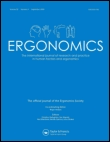
THEORETICAL ISSUES IN ERGONOMICS SCIENCE
Scope & Guideline
Exploring the Frontiers of Ergonomics Theory
Introduction
Aims and Scopes
- Human-Computer Interaction (HCI):
The journal emphasizes research on the interaction between humans and computers, examining how design and technology can optimize user experience and performance. - Workplace Ergonomics and Safety:
A core area of focus is the assessment of ergonomic risks in workplace settings, aiming to improve worker safety and reduce the incidence of musculoskeletal disorders. - Cognitive Ergonomics:
The journal addresses cognitive aspects of ergonomics, including decision-making processes, mental workload, and the psychological impact of technology on users. - Emerging Technologies and Automation:
Research on the implications of automation and emerging technologies, such as autonomous vehicles and AI systems, is a significant aspect, analyzing how these innovations affect human interaction. - Participatory Ergonomics:
The journal promotes participatory approaches in ergonomics, involving stakeholders in the design and assessment processes to enhance system usability and safety. - Methodological Innovations:
Methodologies for assessing ergonomic factors, including quantitative and qualitative research approaches, are highlighted to advance the field's theoretical foundations.
Trending and Emerging
- Health and Well-being in the Context of Covid-19:
Research exploring health risks and ergonomic challenges faced by workers during the Covid-19 pandemic has surged, highlighting the importance of ergonomics in health and safety. - Human-Autonomy Interaction:
There is a growing focus on understanding and improving the interaction between humans and autonomous systems, especially in sectors like transportation and manufacturing. - Cognitive Load and Decision-Making in Complex Systems:
Emerging studies examine cognitive load and decision-making processes in complex systems, providing insights into how to design better support systems for users. - Virtual and Augmented Reality Applications:
The application of virtual and augmented reality in ergonomics research is trending, particularly for training and simulation purposes within various industries. - Sustainability and Ergonomics:
Research integrating sustainability principles with ergonomic design is on the rise, reflecting an increasing awareness of environmental impact alongside user well-being. - Participatory and Inclusive Design:
The trend towards participatory and inclusive design practices is gaining traction, emphasizing the need to involve diverse user groups in the ergonomics design process.
Declining or Waning
- Traditional Ergonomics in Static Environments:
Research focusing on static ergonomic assessments in traditional office settings has decreased, likely due to the increasing relevance of dynamic and flexible workspaces. - Basic Human Factors in Isolation:
Studies that address basic human factors in isolation, without considering the broader context of human-system interaction, are becoming less common as the field moves toward more integrative approaches. - Physical Ergonomics in Non-Industrial Settings:
There has been a waning interest in physical ergonomics research in non-industrial settings, such as home offices or educational environments, as the focus shifts to more complex environments involving technology. - Single-Disciplinary Approaches:
Research that adopts a single-disciplinary perspective on ergonomics is declining, with a growing emphasis on interdisciplinary approaches that integrate insights from psychology, engineering, and design.
Similar Journals

INTERACTING WITH COMPUTERS
Advancing Insights in Human-Computer InteractionINTERACTING WITH COMPUTERS is a renowned journal published by Oxford University Press, focusing on the interdisciplinary field of Human-Computer Interaction, as well as aspects of Library and Information Sciences and Software. With a rich history of publication since 1989, this journal has established itself as a significant platform for scholars to disseminate cutting-edge research and innovative methodologies that enhance our understanding of how humans engage with technology. Despite being classified in the Q3 and Q2 quartiles across various categories, its 2023 Scopus rankings highlight its relevance, positioning it within the 69th percentile for Library and Information Sciences. This makes it an essential resource for researchers, professionals, and students looking to stay informed about the latest advancements and discussions in this rapidly evolving domain. Though not currently open access, INTERACTING WITH COMPUTERS offers substantial insights that are crucial for driving forward the conversation in Human-Computer Interaction, ensuring its relevance in both academic and applied contexts.

International Journal of Aviation Aeronautics and Aerospace
Elevating Research in Aviation and Aerospace InnovationInternational Journal of Aviation Aeronautics and Aerospace, published by Embry-Riddle Aeronautical University, serves as a pivotal platform for the dissemination of innovative research in the fields of aerospace engineering, civil and structural engineering, and safety, risk, reliability, and quality. With an ISSN of 2374-6793 and designated as an open access journal since 2014, it enables unhindered global access to its scholarly content, fostering collaboration among researchers, professionals, and students in the aviation sector. The journal's presence spans from 2014 to 2024 and is recognized within the Q3 category across multiple engineering domains according to recent metrics. Despite its emerging status, it holds respectable rankings in Scopus, demonstrating its relevance and contribution to the academic community, particularly in dynamic engineering sectors. It is an essential resource for anyone looking to enhance their understanding of advancements and challenges in aviation and aerospace solutions.

Dyna
Connecting academia and industry for transformative engineering solutions.Dyna, with the ISSN 0012-7361 and E-ISSN 1989-1490, is a prominent academic journal published by the Federación Asociaciones Ingenieros Industriales España. Situated in Spain, it is dedicated to advancing knowledge and research in the field of engineering, specifically focusing on diverse aspects within the Engineering (Miscellaneous) category. With a current Scopus rank of #245 out of 307, Dyna operates in the 20th percentile, emphasizing the journal’s commitment to fostering innovation and dialogue among scholars and industry practitioners alike. Although it operates under traditional access models, the journal is pivotal for researchers, professionals, and students seeking to contribute to the evolving landscape of engineering disciplines. Covering a broad range of topics from 2009 to 2024, Dyna aims to facilitate interdisciplinary collaboration and disseminate cutting-edge findings that can influence both academia and industry.

INTERNATIONAL JOURNAL OF HUMAN-COMPUTER INTERACTION
Exploring the Synergy Between Humans and TechnologyINTERNATIONAL JOURNAL OF HUMAN-COMPUTER INTERACTION, published by Taylor & Francis Inc, stands at the forefront of research within the interdisciplinary fields of human-computer interaction, human factors, and ergonomics. Since its establishment, the journal has consistently contributed to advancing the understanding of the interactions between people and computers, making it a vital resource for researchers, professionals, and students alike. With an impressive impact factor reflecting its high citation rate, this journal is recognized as a Q1 publication in both Computer Science Applications and Human Factors and Ergonomics categories for 2023, showcasing its stature within the academic community. Additionally, it boasts a commendable ranking within the top percentiles in key areas on Scopus, ensuring that the research published here reaches broad scholarly audiences. Available in traditional subscription format, the journal covers seminal studies from 1989 to 2024, reflecting ongoing innovation in technology and its applications in everyday life, and thus serves as an essential platform for pioneering research that shapes the future of user experience.

Zentralblatt fur Arbeitsmedizin Arbeitsschutz und Ergonomie
Pioneering Research in Occupational Safety and ErgonomicsZentralblatt für Arbeitsmedizin, Arbeitsschutz und Ergonomie, published by Springer Heidelberg, is a pivotal academic journal dedicated to the fields of public health, occupational safety, and ergonomics. With an ISSN of 0944-2502 and an E-ISSN of 2198-0713, this journal has been serving the academic community since its inception in 1953, covering a breadth of topics related to workplace health and safety practices. Although currently classified in the Q4 quartile in Public Health, Environmental, and Occupational Health, the journal continues to publish valuable research that impacts both practitioners and policymakers in these essential fields. The journal’s scope encompasses a wide range of studies, evaluations, and methodologies aimed at improving occupational health standards and ergonomic practices. With access options that facilitate global dissemination of knowledge, it aims to foster collaboration and innovation among professionals, researchers, and students committed to enhancing workplace well-being and safety.

ERGONOMICS
Bridging the gap between people and their environments.ERGONOMICS is a premier journal that serves the dynamic fields of Human Factors and Ergonomics, as well as Physical Therapy, Sports Therapy, and Rehabilitation. Published by Taylor & Francis Ltd in the United Kingdom, this journal not only boasts a commendable impact factor but also holds a Q2 quartile ranking across its categories, underscoring its influence and academic rigor. With a convergence of significant research dating back to 1957, ERGONOMICS provides a multifaceted platform for the dissemination and discussion of innovative findings that enhance the interaction between people and their environments. Although the journal does not offer Open Access options, it remains a vital resource for researchers, professionals, and students seeking to deepen their understanding of ergonomic principles and applications. Positioned at the intersection of health and human behavior, ERGONOMICS is dedicated to advancing knowledge and promoting best practices in an era where the demand for safe and efficient work environments continues to grow.

MM Science Journal
Shaping the Future of Engineering with Every Publication.MM Science Journal is a leading publication in the fields of Automotive Engineering, Electrical and Electronic Engineering, Industrial and Manufacturing Engineering, and Mechanical Engineering, published by MM SCIENCE. Established in 2014 and spanning a converged period to 2024, this journal serves as a crucial platform for disseminating innovative research and practical applications relevant to industry professionals and academic scholars alike. With a notable Q3 ranking in multiple engineering categories and Scopus Ranks placing it in the 35th to 25th percentiles across various disciplines, MM Science Journal is committed to advancing knowledge and fostering collaboration in engineering disciplines. Although not currently an open-access publication, the journal remains instrumental for those seeking to engage with cutting-edge developments in engineering from its base in the Czech Republic. Researchers, students, and professionals are encouraged to explore the rich findings shared within its pages, contributing to the ongoing evolution of engineering practices.

DISPLAYS
Exploring Cutting-Edge Research in Display SystemsDISPLAYS is a prestigious journal published by Elsevier that focuses on the dynamic intersection of Electrical and Electronic Engineering, Hardware and Architecture, and Human-Computer Interaction. Since its inception in 1979, the journal has made significant contributions to advancing the field, currently holding a notable impact factor and ranking within the Q2 category across multiple disciplines, including Electrical and Electronic Engineering, Hardware and Architecture, and Human-Computer Interaction. With its broad scope, DISPLAYS is dedicated to publishing high-quality research that inspires innovation in display technology and its applications. Researchers and professionals benefit from access to cutting-edge findings in the realm of display systems, which are integral to the evolving landscape of digital interaction. Operating without an open access option, the journal ensures rigorous peer review, maintaining the highest standards of academic integrity and research quality. Positioned in the heart of the Netherlands, DISPLAYS continues to play a critical role in shaping future advancements, making it an essential read for anyone committed to these vital fields of study.

AUTOMATION IN CONSTRUCTION
Pioneering Innovations in Construction TechnologyAUTOMATION IN CONSTRUCTION is a premier academic journal published by Elsevier, dedicated to advancing the fields of Building and Construction, Civil and Structural Engineering, and Control and Systems Engineering. Since its inception in 1992, this journal has served as a vital platform for disseminating innovative research and practical applications in automation technologies within the construction industry. With a distinguished 2023 impact factor reflected in its Q1 ranking across multiple engineering categories—securing rank #3 in Civil and Structural Engineering and rank #3 in Building and Construction—AUTOMATION IN CONSTRUCTION stands out as a leading resource for researchers, professionals, and students keen on staying at the forefront of this rapidly evolving field. The journal offers access to cutting-edge studies that explore automation processes, methodologies, and tools, contributing to the enhancement of productivity and sustainability in construction practices. With contributions from global experts, each issue of AUTOMATION IN CONSTRUCTION provides comprehensive insights that help drive innovation and foster collaboration.

International Journal of AEROSPACE Psychology
Transforming Aerospace Psychology ResearchInternational Journal of Aerospace Psychology is a premier publication dedicated to advancing the interdisciplinary field of aerospace psychology, addressing the cognitive, emotional, and behavioral aspects of human interaction with aerospace environments. Published by Taylor & Francis Inc., this journal occupies a pivotal position in the academic landscape with its Q2 ranking in Aerospace Engineering and Q3 rankings in Applied Psychology and Computer Science Applications, reflecting its commitment to high-impact research. With an ISSN of 2472-1832 and E-ISSN of 2472-1840, it is accessible through open access options, ensuring that cutting-edge research reaches a wide audience of researchers, practitioners, and students. Covering a broad scope from psychological implications in aerospace systems to educational methodologies in this domain, the journal spans converged years from 2017 to 2024. The Scopus rankings further reinforce the journal's significance, with notable standings within multiple categories, making it an essential resource for those at the intersection of aerospace, psychology, and technology.